单晶硅纳米力学性能的测试
- 格式:pdf
- 大小:488.02 KB
- 文档页数:7
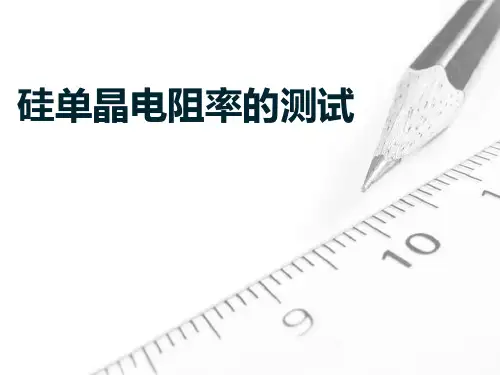
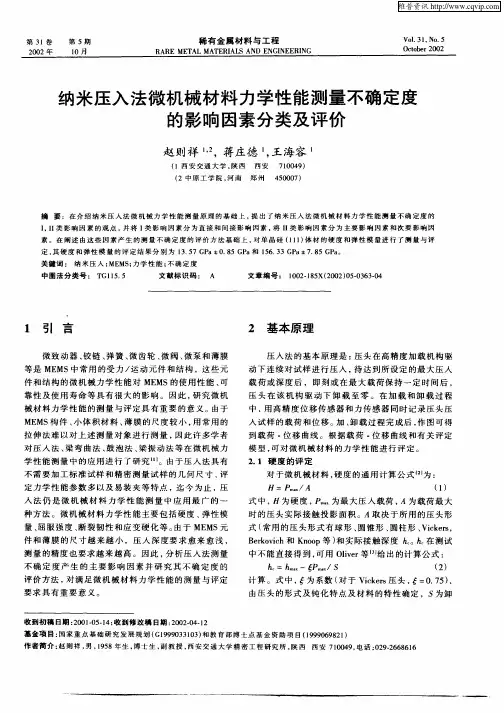
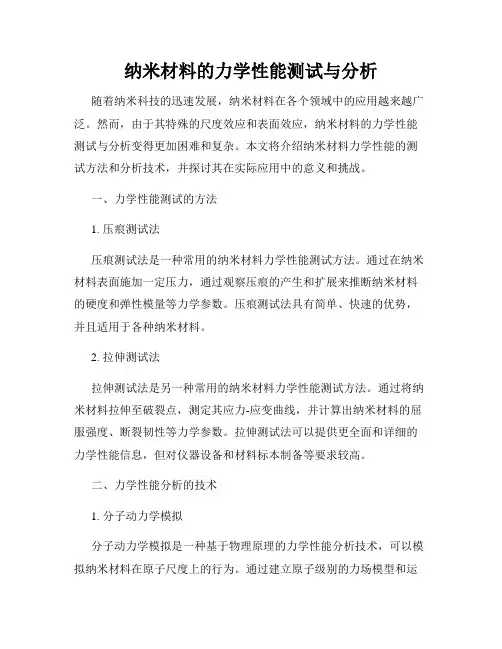
纳米材料的力学性能测试与分析随着纳米科技的迅速发展,纳米材料在各个领域中的应用越来越广泛。
然而,由于其特殊的尺度效应和表面效应,纳米材料的力学性能测试与分析变得更加困难和复杂。
本文将介绍纳米材料力学性能的测试方法和分析技术,并探讨其在实际应用中的意义和挑战。
一、力学性能测试的方法1. 压痕测试法压痕测试法是一种常用的纳米材料力学性能测试方法。
通过在纳米材料表面施加一定压力,通过观察压痕的产生和扩展来推断纳米材料的硬度和弹性模量等力学参数。
压痕测试法具有简单、快速的优势,并且适用于各种纳米材料。
2. 拉伸测试法拉伸测试法是另一种常用的纳米材料力学性能测试方法。
通过将纳米材料拉伸至破裂点,测定其应力-应变曲线,并计算出纳米材料的屈服强度、断裂韧性等力学参数。
拉伸测试法可以提供更全面和详细的力学性能信息,但对仪器设备和材料标本制备等要求较高。
二、力学性能分析的技术1. 分子动力学模拟分子动力学模拟是一种基于物理原理的力学性能分析技术,可以模拟纳米材料在原子尺度上的行为。
通过建立原子级别的力场模型和运动方程,可以模拟纳米材料的结构演化、应力分布等力学性能表现。
分子动力学模拟可以提供丰富的细节信息,但计算复杂度较高。
2. 有限元分析有限元分析是一种基于数值计算的力学性能分析技术,可以模拟纳米材料在宏观尺度上的行为。
通过将纳米材料离散化为有限数量的单元,并考虑边界条件和加载情况,可以计算出纳米材料的应力分布、形变情况等力学性能参数。
有限元分析具有较高的计算效率和适用性。
三、实际应用与挑战纳米材料的力学性能测试与分析在材料科学、机械工程等领域中具有重要的应用价值。
能够准确了解和评估纳米材料的力学性能,对于设计和制造具有优异性能的纳米材料产品具有重要意义。
然而,纳米材料的力学性能测试与分析也面临一些挑战。
首先,纳米材料的尺度效应和表面效应使得传统力学理论无法直接适用于纳米材料的力学性能预测和分析。
其次,针对纳米材料的测试方法和分析技术需要更高的精度和灵敏度,以满足纳米材料特殊性能的需求。
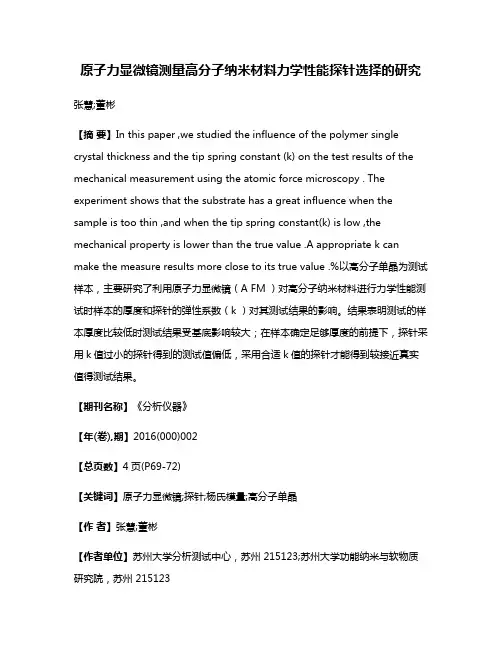
原子力显微镜测量高分子纳米材料力学性能探针选择的研究张慧;董彬【摘要】In this paper ,we studied the influence of the polymer single crystal thickness and the tip spring constant (k) on the test results of the mechanical measurement using the atomic force microscopy . The experiment shows that the substrate has a great influence when the sample is too thin ,and when the tip spring constant(k) is low ,the mechanical property is lower than the true value .A appropriate k can make the measure results more close to its true value .%以高分子单晶为测试样本,主要研究了利用原子力显微镜(A FM )对高分子纳米材料进行力学性能测试时样本的厚度和探针的弹性系数(k )对其测试结果的影响。
结果表明测试的样本厚度比较低时测试结果受基底影响较大;在样本确定足够厚度的前提下,探针采用k值过小的探针得到的测试值偏低,采用合适k值的探针才能得到较接近真实值得测试结果。
【期刊名称】《分析仪器》【年(卷),期】2016(000)002【总页数】4页(P69-72)【关键词】原子力显微镜;探针;杨氏模量;高分子单晶【作者】张慧;董彬【作者单位】苏州大学分析测试中心,苏州 215123;苏州大学功能纳米与软物质研究院,苏州 215123【正文语种】中文原子力显微镜(AFM)现在已经成为表征材料的表面形貌的一种重要手段。
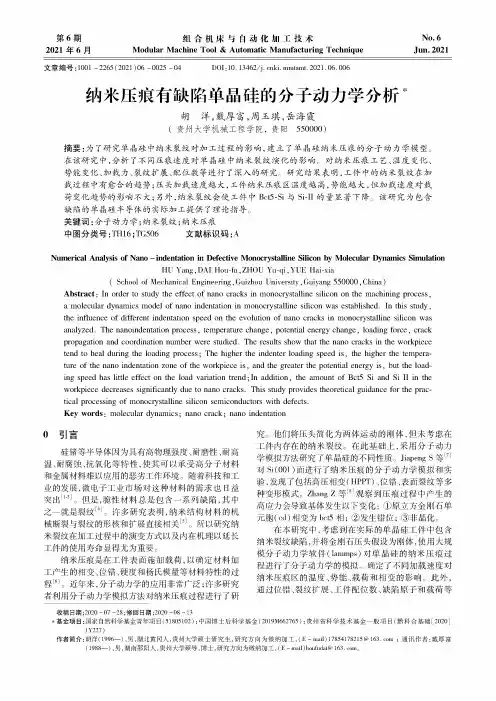
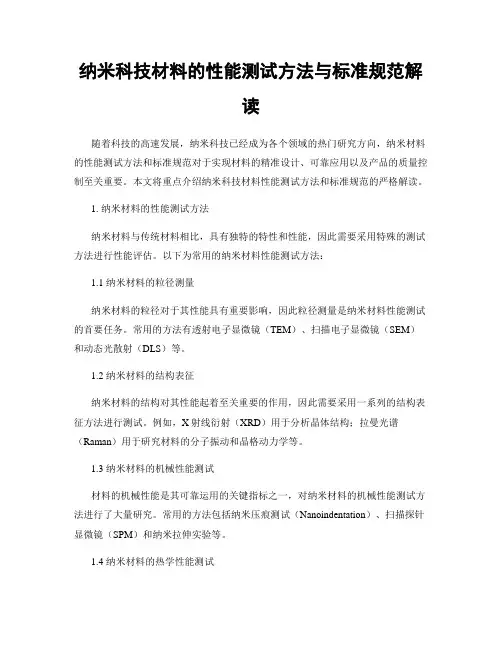
纳米科技材料的性能测试方法与标准规范解读随着科技的高速发展,纳米科技已经成为各个领域的热门研究方向,纳米材料的性能测试方法和标准规范对于实现材料的精准设计、可靠应用以及产品的质量控制至关重要。
本文将重点介绍纳米科技材料性能测试方法和标准规范的严格解读。
1. 纳米材料的性能测试方法纳米材料与传统材料相比,具有独特的特性和性能,因此需要采用特殊的测试方法进行性能评估。
以下为常用的纳米材料性能测试方法:1.1 纳米材料的粒径测量纳米材料的粒径对于其性能具有重要影响,因此粒径测量是纳米材料性能测试的首要任务。
常用的方法有透射电子显微镜(TEM)、扫描电子显微镜(SEM)和动态光散射(DLS)等。
1.2 纳米材料的结构表征纳米材料的结构对其性能起着至关重要的作用,因此需要采用一系列的结构表征方法进行测试。
例如,X射线衍射(XRD)用于分析晶体结构;拉曼光谱(Raman)用于研究材料的分子振动和晶格动力学等。
1.3 纳米材料的机械性能测试材料的机械性能是其可靠运用的关键指标之一,对纳米材料的机械性能测试方法进行了大量研究。
常用的方法包括纳米压痕测试(Nanoindentation)、扫描探针显微镜(SPM)和纳米拉伸实验等。
1.4 纳米材料的热学性能测试纳米材料的热学性能对于其在能源、催化等领域的应用至关重要。
因此,研究者们开发了一系列测试方法,如差示扫描量热法(DSC)、热导率测试仪和纳米量热仪等。
2. 纳米材料性能测试的标准规范解读为了保证纳米科技材料性能测试的准确性和可比性,各个国家和国际组织制定了相应的标准规范,以规定测试方法和要求。
下面将重点介绍几个重要的标准规范:2.1 ISO/TS 80004-1:2015该标准主要针对纳米材料的术语和定义进行了规范,为纳米科技材料的研究和应用提供了统一的术语和定义。
它为纳米材料的性质表征和测试提供了一个共同的基础。
2.2 ISO/TS 12901-2:2014该标准规范了纳米材料亲水性和疏水性的测试方法和评价准则,以及纳米颗粒在液体中的分散性评价指标,对于纳米材料的应用和环境影响研究具有重要意义。
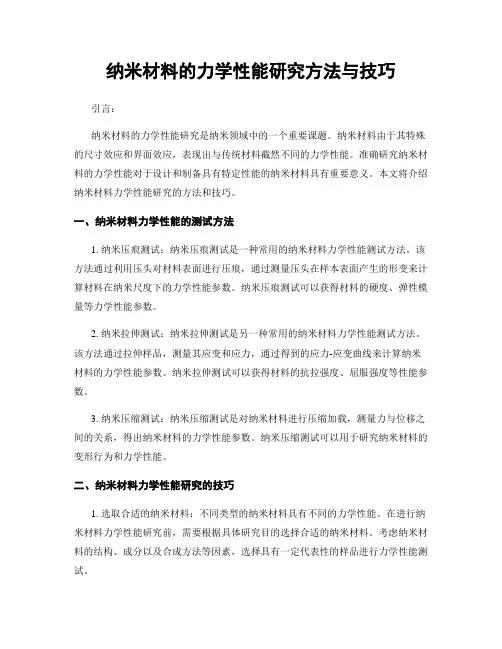
纳米材料的力学性能研究方法与技巧引言:纳米材料的力学性能研究是纳米领域中的一个重要课题。
纳米材料由于其特殊的尺寸效应和界面效应,表现出与传统材料截然不同的力学性能。
准确研究纳米材料的力学性能对于设计和制备具有特定性能的纳米材料具有重要意义。
本文将介绍纳米材料力学性能研究的方法和技巧。
一、纳米材料力学性能的测试方法1. 纳米压痕测试:纳米压痕测试是一种常用的纳米材料力学性能测试方法。
该方法通过利用压头对材料表面进行压痕,通过测量压头在样本表面产生的形变来计算材料在纳米尺度下的力学性能参数。
纳米压痕测试可以获得材料的硬度、弹性模量等力学性能参数。
2. 纳米拉伸测试:纳米拉伸测试是另一种常用的纳米材料力学性能测试方法。
该方法通过拉伸样品,测量其应变和应力,通过得到的应力-应变曲线来计算纳米材料的力学性能参数。
纳米拉伸测试可以获得材料的抗拉强度、屈服强度等性能参数。
3. 纳米压缩测试:纳米压缩测试是对纳米材料进行压缩加载,测量力与位移之间的关系,得出纳米材料的力学性能参数。
纳米压缩测试可以用于研究纳米材料的变形行为和力学性能。
二、纳米材料力学性能研究的技巧1. 选取合适的纳米材料:不同类型的纳米材料具有不同的力学性能。
在进行纳米材料力学性能研究前,需要根据具体研究目的选择合适的纳米材料。
考虑纳米材料的结构、成分以及合成方法等因素,选择具有一定代表性的样品进行力学性能测试。
2. 样品制备的标准化:样品制备对于纳米材料力学性能研究的结果具有重要影响。
因此,要确保样品制备的标准化和重复性。
在制备样品时应注意控制纳米颗粒的尺寸、形貌和分散性,避免影响力学性能测试的因素。
3. 合理选择性能测试参数:在进行纳米材料力学性能测试时,需要根据具体样品的特点和测试目的,选择合适的测试参数。
例如,在纳米压痕测试中,应根据样品的硬度范围选择合适的压头,以保证测试结果的准确性。
4. 结合理论计算与实验:纳米材料力学性能的研究需要结合理论计算与实验相结合。
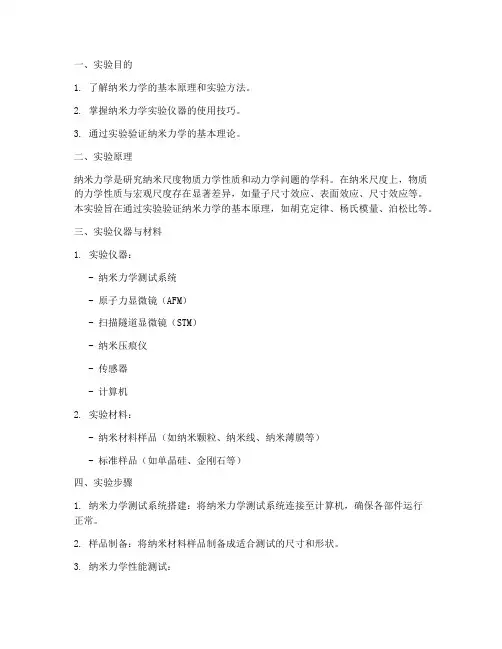
一、实验目的1. 了解纳米力学的基本原理和实验方法。
2. 掌握纳米力学实验仪器的使用技巧。
3. 通过实验验证纳米力学的基本理论。
二、实验原理纳米力学是研究纳米尺度物质力学性质和动力学问题的学科。
在纳米尺度上,物质的力学性质与宏观尺度存在显著差异,如量子尺寸效应、表面效应、尺寸效应等。
本实验旨在通过实验验证纳米力学的基本原理,如胡克定律、杨氏模量、泊松比等。
三、实验仪器与材料1. 实验仪器:- 纳米力学测试系统- 原子力显微镜(AFM)- 扫描隧道显微镜(STM)- 纳米压痕仪- 传感器- 计算机2. 实验材料:- 纳米材料样品(如纳米颗粒、纳米线、纳米薄膜等)- 标准样品(如单晶硅、金刚石等)四、实验步骤1. 纳米力学测试系统搭建:将纳米力学测试系统连接至计算机,确保各部件运行正常。
2. 样品制备:将纳米材料样品制备成适合测试的尺寸和形状。
3. 纳米力学性能测试:- 使用AFM测试样品的表面形貌和粗糙度。
- 使用STM测试样品的表面电学性质。
- 使用纳米压痕仪测试样品的杨氏模量和泊松比。
- 使用传感器测试样品的力学响应。
4. 数据处理与分析:将实验数据导入计算机,进行数据处理和分析。
五、实验结果与分析1. AFM测试结果显示,样品表面光滑,无明显缺陷。
2. STM测试结果显示,样品表面电学性质良好。
3. 纳米压痕测试结果显示,样品的杨氏模量为X GPa,泊松比为Y。
4. 传感器测试结果显示,样品的力学响应与理论值基本一致。
六、实验结论1. 本实验成功验证了纳米力学的基本原理,如胡克定律、杨氏模量、泊松比等。
2. 实验结果与理论值基本一致,表明纳米力学实验方法可靠。
3. 纳米力学在纳米材料研究和应用中具有重要意义。
七、实验心得1. 纳米力学实验需要精确的仪器和操作技巧,对实验人员要求较高。
2. 纳米力学实验结果受多种因素影响,如样品制备、测试环境等。
3. 纳米力学实验为纳米材料研究和应用提供了有力支持。
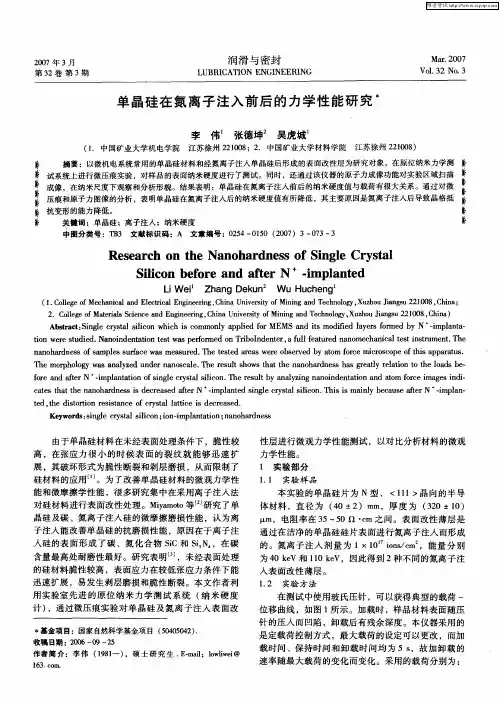
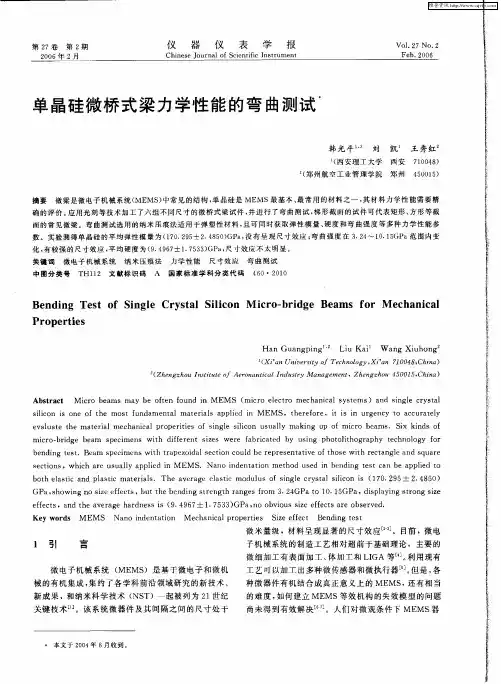
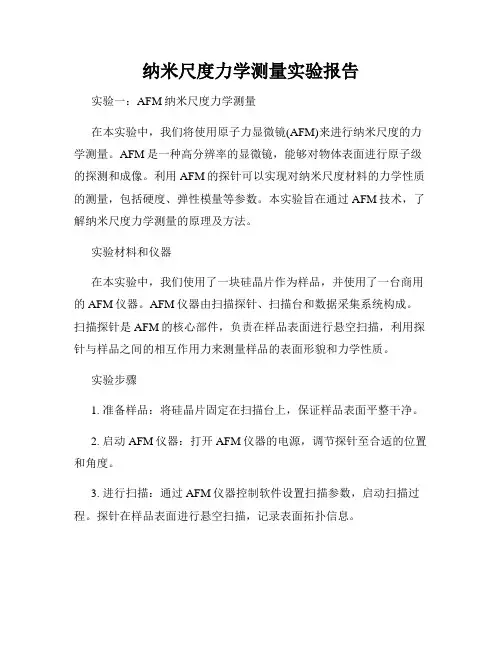
纳米尺度力学测量实验报告实验一:AFM纳米尺度力学测量在本实验中,我们将使用原子力显微镜(AFM)来进行纳米尺度的力学测量。
AFM是一种高分辨率的显微镜,能够对物体表面进行原子级的探测和成像。
利用AFM的探针可以实现对纳米尺度材料的力学性质的测量,包括硬度、弹性模量等参数。
本实验旨在通过AFM技术,了解纳米尺度力学测量的原理及方法。
实验材料和仪器在本实验中,我们使用了一块硅晶片作为样品,并使用了一台商用的AFM仪器。
AFM仪器由扫描探针、扫描台和数据采集系统构成。
扫描探针是AFM的核心部件,负责在样品表面进行悬空扫描,利用探针与样品之间的相互作用力来测量样品的表面形貌和力学性质。
实验步骤1. 准备样品:将硅晶片固定在扫描台上,保证样品表面平整干净。
2. 启动AFM仪器:打开AFM仪器的电源,调节探针至合适的位置和角度。
3. 进行扫描:通过AFM仪器控制软件设置扫描参数,启动扫描过程。
探针在样品表面进行悬空扫描,记录表面拓扑信息。
4. 力谱测量:选择合适的力谱测量模式,对样品进行力学性质的测量。
根据探针在样品表面的变形情况,计算出样品在纳米尺度下的力学参数。
实验结果与分析通过AFM测量,我们得到了硅晶片在纳米尺度下的力学性质数据。
根据力谱测量曲线,我们可以得到样品表面的硬度、弹性模量等参数。
实验结果表明,在纳米尺度下,硅晶片表现出较高的硬度和弹性模量,这与其微观结构和化学成分密切相关。
实验结论本实验利用AFM技术对硅晶片进行了纳米尺度的力学测量,得到了样品在纳米尺度下的力学性质参数。
通过实验,我们进一步认识了纳米尺度下物体的力学特性,为纳米尺度力学研究提供了重要的实验数据。
希望通过本实验,同学们能够加深对纳米尺度力学测量的理解,为未来的科学研究奠定基础。
实验感想本实验是一次很有趣的实践活动,通过自己动手进行AFM测量,深刻感受到了纳米尺度下物体的微观特性。
在实验过程中,遇到了一些困难和挑战,但通过不断的实践和思考,最终取得了令人满意的实验结果。
单晶硅多晶硅力学1 单晶硅的力学性能单晶硅是一种高纯度的非金属材料,其晶体结构类似于钻石。
单晶硅具有非常优异的力学性能,具体表现在以下几个方面。
1.1 抗拉强度和断裂韧性单晶硅的抗拉强度非常高,可以达到1.6GPa以上。
同时,单晶硅的断裂韧性也比较好,通常为0.9-1.0MPa·m1/2。
这些性能使得单晶硅成为一种理想的微机电系统(MEMS)材料,能够承受高的机械应力和不同的热力环境。
1.2 压电效应单晶硅还具有压电效应,即在外加电场或机械应力下,会产生电荷分布和电势差。
这种特性使得单晶硅可以用于传感器、闸门和执行机构等领域。
1.3 弹性模量和泊松比单晶硅的弹性模量通常为130-190GPa,泊松比为0.21-0.24。
这些性能使得单晶硅可以作为微结构的薄膜材料和微弹性元件的材料。
2 多晶硅的力学性能多晶硅是由许多晶粒组成的一种材料,晶粒之间的取向不同。
多晶硅的力学性能与单晶硅有很大的不同。
2.1 强度和断裂韧性相对于单晶硅,多晶硅的强度要低得多,只有300-400MPa。
断裂韧性也相对较低,通常在0.2-0.4MPa·m1/2之间。
因此,多晶硅在MEMS领域的应用受到一定限制,通常只用于一些较低要求的元器件。
2.2 疲劳性能多晶硅的疲劳性能比单晶硅差,容易出现疲劳裂纹和断裂。
这是因为多晶硅中的晶粒会在应力下发生滑移和旋转,导致材料中出现微观裂纹,最终导致断裂。
2.3 弹性模量和泊松比多晶硅的弹性模量通常为150-180GPa,泊松比为0.22-0.26。
相比于单晶硅,多晶硅的弹性模量要低得多。
3 单晶硅和多晶硅的比较从上面的分析可以看出,单晶硅和多晶硅的力学性能有很大的差别。
单晶硅的强度和断裂韧性等性能明显优于多晶硅,但是单晶硅的制造过程比较复杂,成本也较高。
相反,多晶硅的制造比较简单,并且价格较低,但是其强度和断裂韧性等性能相对较低。
因此,在不同的应用场合中,需要根据实际情况选择不同的材料。
M EMS器件与技术M EMS Device&Technology单晶硅纳米压痕过程的有限元模拟与实验验证陈 樟1,2,苏 伟2,万 敏1(1.北京航空航天大学机械工程及自动化学院,北京 100083;2.中国工程物理研究院电子工程研究所,四川 绵阳 621900)摘要:采用商用有限元软件ABAQU S建立了单晶硅纳米压痕过程的2D轴对称模型,通过分析模拟得到载荷-位移曲线,讨论了压头尖端半径、压头与样品间的摩擦系数对压痕过程的影响规律。
为了验证模拟结果的有效性,用美国Hysit ron公司的Triboindenter纳米压痕仪进行了实验。
由仿真结果可知,在固定压深的条件下,增大压头尖端半径,所需施加的载荷增加,弹性回复程度增加。
而摩擦系数的改变对压痕过程影响不大,可以在模拟中忽略不计。
对比仿真曲线和实验曲线,实验曲线在卸载段55nm处出现了一明显拐点,使得其弹性回复程度远大于模拟的结果。
这是由于高压诱导的相变导致了单晶硅纳米压痕过程中出现了复杂的本构关系,而有限元软件中还没有如此复杂的本构关系模型。
关键词:纳米压痕;有限元模拟;微纳米技术;微纳尺度;相变中图分类号:O242.21;TN304.12 文献标识码:A 文章编号:1671-4776(2009)02-0104-04FEM Simulation and Experiment V erif ication of the MonocrystalSilicon N anoindentation ProcessChen Zhang1,2,Su Wei2,Wan Min1(1.S chool of Mechanical Engineeri ng and A utomation,B ei hang Universit y,B ei j ing100083,China;2.I nstitute of Elect ronic Engineering,China A cadem y of Engineering Physics,Miany ang621900,China)Abstract:2D axisymmetric finite element model(FEM)was established for monocrystal silicon nanoindentation p rocess wit h commercial finite element software package ABAQU S.The effect of the indenter tip radius and the friction coefficient between the nano2indenter and sample material on the nanoindentation process were discussed by analyzing t he load2displacement curves f rom simulation.The experiment s were made wit h Triboindenter of Hysit ron,Inc.to verify t he effectiveness of simulation result s.For a given indentation dept h,t he applied load and elastic recovery increases wit h a tip radius increasing.The change of friction coefficient influences quite little on indenta2 tion p rocess,which is ignored during t he paring t he simulation and experiment curves,an obvious elbow is discovered in experimental curves,because of p hase t ransformation induced by high pressure,which causes complex constit utive relations during nanoindentation for which FEM hasn’t t his model.K ey w ords:nanoindentation;finite element simulation;micro/nano technology;micro/nano scale;p hase t ransformationEEACC:6185;6220收稿日期:2008-10-09E2m ail:czcaep@0 引 言力学性能是评价材料质量的主要指标,也是进行设计与计算的主要依据[1]。
单晶硅弯曲强度-回复单晶硅是一种具有高纯度和晶体结构完美的硅材料,具有许多重要的应用领域。
其在光电子、微电子、太阳能等行业得到广泛应用。
其中,单晶硅的弯曲强度是一个重要的物理性质,直接影响到其在工程中的可靠性和稳定性。
本文将详细介绍单晶硅的弯曲强度,从基本概念到测试方法,一步一步回答读者的问题。
1. 什么是单晶硅弯曲强度?单晶硅的弯曲强度是指在外力作用下,单晶硅试样的抗弯程度。
简单来说,它衡量了单晶硅在弯曲加载下的抗变形能力和断裂强度。
弯曲强度是一个重要的力学参数,可以衡量材料的韧性和可靠性。
2. 单晶硅的弯曲强度与其结构有何关系?单晶硅由于其完美的晶体结构和高纯度,具有优秀的力学性能。
其弯曲强度与晶格结构的完整性和晶界的缺陷密切相关。
晶界缺陷是指晶体中晶格方向、晶格常数和晶体结构的突变部分。
晶界缺陷存在于材料的晶界或晶界内。
这些缺陷会影响单晶硅的弯曲强度,因为它们在外力加载时可能成为断裂点。
3. 如何测试单晶硅的弯曲强度?测试单晶硅的弯曲强度通常使用三点弯曲试验方法。
测试流程如下:第一步:准备单晶硅试样。
常用的试样形状包括矩形、圆形等。
试样的尺寸和形状应根据具体需求设计,并严格按照相关标准进行加工制备。
第二步:加装试样。
将试样放置在测试装置上,使其位于两个支撑点之间,并确保试样的表面平整。
第三步:施加力。
用压力加载系统逐渐施加力,使试样发生弯曲。
同时,可以通过应变计等测量设备监测试样的变形情况。
第四步:记录数据。
在加载的过程中,记录试样的负载和位移等数据。
在试样达到断裂点或指定的载荷时停止加载。
第五步:计算结果。
根据采集到的数据,计算出单晶硅的弯曲强度。
4. 单晶硅弯曲强度的影响因素有哪些?单晶硅的弯曲强度受到多个因素的影响,包括晶格结构完整性、晶界缺陷、试样尺寸、测试速率、温度等。
晶格结构的完整性越高,晶界缺陷越少,单晶硅的弯曲强度越高。
此外,试样尺寸越大,弯曲强度通常越低;测试速率越快,弯曲强度通常越低;在高温下,单晶硅的弯曲强度通常会降低。
硅酸盐学报· 1484 ·2007年连续刚度法对单晶硅片的力学性能的表征孙玉利,左敦稳,朱永伟,徐锋,王珉(南京航空航天大学机电学院,南京 210016)摘要:利用纳米压痕仪通过连续刚度测量法对单晶硅片在压入过程中的接触刚度、硬度、弹性模量进行了连续测量。
结果表明:当接触深度在20~32nm左右时,单晶硅片的接触刚度与接触深度成直线关系,硬度和弹性模量基本保持不变,此时所测得的是单晶硅片表面氧化层的硬度和弹性模量,分别约为10.2GPa和140.3GPa。
当接触深度在32~60nm左右时,单晶硅片的接触刚度与接触深度成非直线关系,硬度和弹性模量随接触深度急剧增加,表明单晶硅片表面氧化层的硬度和弹性模量受到了基体材料的影响。
当接触深度在60nm以上时,单晶硅片的接触刚度与接触深度成直线关系,硬度和弹性模量基本保持不变,测得值为单晶硅的硬度和弹性模量,分别约为12.5GPa和165.6GPa。
关键词:连续刚度法;单晶硅片;纳米压痕;力学性能中图分类号:TQ302.3 文献标识码:A 文章编号:0454–5648(2007)11–1484–04MECHANICAL PROPERTIES OF SILICON WAFER CHARACTERIZED BY CONTINUOUSSTIFFNESS MEASUREMENT TECHNIQUESUN Yuli,ZUO Dunwen,ZHU Yongwei,XU Feng,WANG Min(College of Mechanical and Electrical Engineering, Nanjing University of Aeronautics and Astronautics, Nanjing 210016, China)Abstract: The contact stiffness, hardness and elastic modulus of silicon wafers were continuously measured during the loading por-tion of an indentation test by a nanoindenter apparatus with the continuous stiffness measurement technique. The results show that when the contact depth is 20–32nm, the relationship of the contact stiffness of the oxide coating on the surface of the silicon wafer with the contact depth is linear, and the hardness and elastic modulus remain constant at 10.2GPa and 140.3GPa respectively. When the contact depth is 32–60nm, the relationship of the contact stiffness with the contact depth is not linear, and the hardness and elastic modulus increase rapidly with the contact depth. It is shown that the hardness and elastic modulus of the oxide coating on the surface of silicon wafer are affected by the bulk material. When the contact depth is over 60nm, the relationship of the contact stiffness of the silicon wafer, e.g., the bulk material, with the contact depth again is linear, and the hardness and elastic modulus stay constant at 12.5 GPa and 165.6GPa, respectively.Key words: continuous stiffness measurement; silicon wafer; nanoindentation; mechanical property集成电路是现代信息产业的核心,是推动国民经济和社会信息化发展最主要的高新技术之一,也是改造和提升传统产业的核心技术,但制造集成电路的硅片,不仅要求具有极高的平面度和极小的表面粗糙度,而且要求表面无变质层、无划伤。
第7卷 第4期2009年7月纳 米 技 术 与 精 密 工 程Nanotechnology and Prec isi on Eng i n eer i n g Vol .7 No .4Jul . 2009Bendi n g Test of Young ′sM odulus of Cryst alli n e Sili conNano 2BeamD I Xiao 2xiao ,Y U Hong(Key Laborat ory of M E MS of M inistry of Educati on,Southeast University,Nanjing 210096,China )Abstract:To study the mechanical perf or mance of the nano 2bea m s,double 2cla mped silicon nano 2bea m s were fabricated based on silicon 2on 2insulat or (S O I )wafer .The Young ′s modulus of silicon nano 2bea m on 〈100〉directi on was measured by bending test method using an at om ic f orce m icr oscope (AF M ).AF M cantilever p r obe is put at the centre of bea m and p resses the bea m ,and then the beam begins t o bend .There is a turning point in the p r ocess of bending .After the point,the bea m is p ressed on the bott om sili 2con of S O Iwafer .The data before turning point can be used t o calculate the sl ope of f orce 2dis p lace ment curve and the data after turning point t o calculate the p r obe sensitivity .The experi m ental values are 01792N /m and 81183nm /V,res pectively .The final measured Young ′s modulus is 104GPa,which is s maller than that of bulk silicon .Surface stress and defects are considered as the reas ons which affect the Young ′s modulus of the nano 2bea m.Keywords:nano 2electr o 2mechanical syste m (NE MS );Young ′s modulus;bending test;double 2cla mped bea m单晶硅纳米梁杨氏模量的弯曲测试邸晓晓,于 虹(东南大学M E MS 教育部重点实验室,南京210096)摘 要:为研究纳米梁的力学特性,采用S O I 晶圆制备了硅双端固支梁纳米梁,利用典型的原子力显微镜(AF M )弯曲测试方法测试了硅纳米梁〈100〉晶向的杨氏模量.AF M 悬臂探针定位在纳米梁的中点处向下移动,纳米梁受到挤压发生弹性形变,形变过程存在一个最大形变点,在该点后,纳米梁被挤压在S O I 硅片底层硅上.最大形变前的测试数据用于计算力2位移曲线斜率,最大形变后的测试数据用于计算探针的灵敏度,其实验值分别为01792N /m 和81183n m /V.最终得到的杨氏模量为104GPa,该值小于体硅的杨氏模量,表面应力和缺陷可能是导致实验值偏小的原因.关键词:纳机电系统;杨氏模量;弯曲测试;双端固支梁中图分类号:T N402;T N403 文献标志码:A 文章编号:167226030(2009)0420324204 收稿日期:2008212215.基金项目:国家重点基础研究发展计划(973)项目(2006CB300404);国家高技术研究发展计划(863)项目(2007AA04Z301).作者简介:邸晓晓(1982— ),男,硕士研究生,dixiaoxiao@hot m ail .com.通讯作者:于 虹,副教授,h yu@seu .edu .cn . Nano 2electr o 2mechanical syste m (NE MS )is a ne wtechnol ogy domain based on m icr o 2electr o 2mechanical syste m (ME MS ).NE MS devices have m inor scales,ul 2tra high frequency and ultra l ow power consump ti on[124].There are many studies on mechanical perf or mance of NE MS devices,f or exa mp le,Young ′s modulus of silicon nano 2bea m s[526].But the experi m ental results are differ 2ent fr om each other,with s ome even contrary t o the oth 2 2009年7月邸晓晓等:单晶硅纳米梁杨氏模量的弯曲测试(英文) ers.This may be because it is difficult t o dep ict the nano device behavi ors in macr o conditi ons.Theref ore measure2 ment technol ogy f or nano scale devices becomes i m portant in exp l oring NE MS m icr o effect.Double2clamped silicon nano2bea m is the basic structure of sens ors and m ixers in NE MS.Fabricating the nano2bea m and studying its mechanical p r operties hold great p ractical value.For nano scale of bea m structure,it is crucial t o fabricate high quality nano2bea m[7210].Elec2 tr onic2bea m(E B)direct writing is often considered as the best way.This paper p resents an app r oach which uses a C MOS standard p r ocess and is compatible with I C p r ocess.The size of the nano2bea m is s o s mall that its mechanical p r operties cannot be measured by traditi onal stretch or t w ist experi m ent.W ith high2res oluti on p r obing equi pment,such as at om ic force m icr oscope(AF M),it becomes easier t o test the mechanical p r operties of the nano2bea m[11213].This paper intr oduces a bending test u2 sing AF M scanning p r obe syste m t o measure the Young′s modulus[14215].Young′s modulus of the double2cla mped silicon nano2bea m on〈100〉directi on is obtained by the bending test.Measured data are compared with those si m ulated by Ansys s oft w are.1 M a ter i a l and exper i m en t a l procedures111 Prepara ti on of spec i m en sSilicon nano2bea m s are fabricated fr om a silicon2on2 insulat or(S O I)wafer with a t op silicon layer of200nm thick and an oxide layer of350n m.The first step of the fabricati on p r ocess is defining the pattern of NE MS re2 s onat ors ont o S O I wafer by op tical lithography.Then re2 active i on etching(R I E)is used t o etch the Si layer and silicon di oxide sacrificial layer.Heavily doped p2type lay2 er is then f or med in the anchor regi on,f oll owed by s put2 tering and etching layers of20n m Ti and600nm A l.Fi2 nally,the nano2structure is released by undercutting the silicon di oxide sacrificial layer with buffered oxide etcher (BOE).Fabricati on p r ocess is shown in Fig.1.SE M and m icr oscope phot ographs of released bea m are shown in Fig.2.It is clear that the bea m is released t otally and there is no adhesi on phenomenon.112 Pr i n c i ple of bend i n g testYoung′s modulus is used t o evaluate material′s re2 sistance t o elastic defor mati on.To obtain the Young′s modulus of the nano2bea m by experi m ent,a f orce is often app lied t o the bea m,which makes the bea m def or m with2 in elasticity range.By measuring the relati onshi p bet w een f orces and dis p lace ments,Young′s modulus is obtained by the exp ressi on as f oll ows: E=S l3192I(1) where S is the sl ope of the f orce2dis p lace ment curve;l is the length of bea m;I is the moment of inertia for the bea m cr oss2secti on.The moment of inertia is given by I=w21+4w1w2+w2236(w1+w2)t3(2)where t is the thickness of the bea m;w1and w2are the t op and bott om widths of the bea m,res pectively.・523・ 纳 米 技 术 与 精 密 工 程第7卷 第4期 I n this experi m ent,an AF M is used t o app ly thef orce t o the bea m.The whole test syste m is sho wn in Fig.3.AF M cantilever p r obe works in contact model and exertsforce continuously on the bea m till the bea m is bent.Then the cantilever p r obe is released at the sa me rate,s owe can receive t w o curves,one is p ressing2down curveand the other is releasing curve.Only p ressing2downcurve is of significance while releasing curve can be ig2nored.Data obtained by AF M test syste m show the rela2ti onshi p bet w een the deflecti on voltageΔV A F M and p iez oe2lectric cera m ic dis p lace ment D p iezo.To obtain the sl ope offorce2dis p lace ment curve S,we need t o convert this rela2ti onshi p int o the f orce2dis p lace ment(F2D)curve of thenano2bea m.Since the dis p lace ment is the actual bea mbending in the f orce directi on,it equals the margin be2t w een the p iez oelectric cera m ic dis p lace ment D p iezo andthe cantilever bending dis p lace ment D tip.So F and D aregiven by F=Ftip=D tip k=ΔV A F M m k(3) D=Dp iezo-D tip=D p iezo-ΔV A F M m(4)where k is the elastic constant of AF M cantilever;m isthe p r obe sensitivity,which can be calculated fr om thep ressing2down curve by m=D p iezoΔVAF M(5)F i g.3 Sche ma ti c of AF M bend i n g test2 Results and d iscussi onI n this experi m ent,the size of the nano2bea m is15μm×012μm×012μm.The high length2t o2width andlength2t o2thickness rati os ensure that it f oll ows linear elas2 tic theory of the is otr op ic materials.Fig.4shows the de2 flecti on voltage versus p iez oelectric cera m ic dis p lace2 ment.W ith the bea m bending increasing,the deflecti on voltage increases until the value reaches the maxi m u m5V.Then the f orce decreases gradually,s o that the bea m bending decreases and the releasing curve is obtained.A s menti oned above,we only study the p ressing2do wn curve.I n Fig.4(a),there is a turning point.The sl ope of curve on the left side of turning point is different fr om that on the right side.Turning point means that the bea m has already been p ressed t o the bott om of S O Iwafer,after which the cantilever ti p acts like p ressing on a hard mate2 rial,s o the curve on the left side of turning point can be used t o calculate the p r obe sensitivity m by Eq.(5). The curve on the right side of turning point is used t o cal2 culate Fand D by Eqs.(3)and(4)res pectively.F i g.4 Force curves of the sili con nano2beam fro mAF M test syste mFig.5(a)sho ws the F2D relati onshi p obtained by Eqs.(3)and(4).Here,m and k are81183nm/V and 0165N/m,res pectively.The si m ulati on result by Ansys s oft w are analysis is shown in Fig.5(b).Both curves are fitted by the least2squares method.For Ansys analysis, we use Young′s modulus of bulk silicon on〈100〉direc2 ti on.The sl opes of curves are01792N/m and01975N/ m,res pectively,and the difference is within8%. Young′s modulus can be calculated by Eqs.(1)and (2).For the silicon nano2bea m on〈100〉directi on,the measured Young′s modulus is104GPa.Young′s modulus obtained by our experi m ent is a lit2 tle s maller than that of bulk silicon.Stress is one of the・623・ 2009年7月邸晓晓等:单晶硅纳米梁杨氏模量的弯曲测试(英文)F i g.5 F2D curves of the nano2beampossi ble reasons t hat affect t he Young′s modulus of the nano2beam.Surf ace st ress may be brought by di fferent fabri cati on processes and has effect on t he str a i n of the nano2beam,and furt her on t he Young′smodulus.Surf ace defect is considered as another reas on t o i m pact on Young′smodulus since the size of the bea m is very s mall.3 Conclusi on sI n this paper,double2cla mped silicon nano2bea m with di m ensi on of15μm×012μm×012μm is fabri2 cated fr om S O Iwafer.Bending test is carried out by AF M t o obtain the Young′s modulus of the silicon nano2bea m. On〈100〉directi on,the measured Young′s modulus is 104GPa,s maller than that of bulk silicon.Surface stress and defects are considered as the reas ons which may af2 fect the Young′s modulus of the nano2bea m.References:[1] ZhangW,Zhou Z,Hao Y,et al.Present situati on and de2vel op ing tendency of NE MS[C]//I ST M6th InternationalSym posium on Test and M easure m ent.Dalian,China,2005,3:226522267.[2] Sandra H.ME MS T oday,NE MS T omorr ow[E B/OL].ht2t p://www.nanoelectr onics p /nanochannels/cir2cuit/A rticle,2002.[3] Craighead H G.Nanoelectr omechanical syste m s[J].Sci2ence,2000,290(24):153221535.[4] Zheng Cui,Gu Changzhi.Nanofabricati on challenges forNE MS[C]//Proceedings of the1st IEEE International Con2 ference on N ano/M icro Engineered and M olecular Syste m s.Zhuhai,China,2006,1:6072610.[5] Carr S M,W ybourne M N.Elastic instability of nanome2chanical bea m s[J].A ppl Phys L ett,2003,82(5):7092 711.[6] L i X,Bhushana B,Takashi m ab K,et al.Mechanical char2acterizati on of m icr o/nanoscale structures for ME MS/NE MSapp licati ons using nanoindentati on techniques[J].U ltram i2 croscopy,2003,97(1/2/3/4):4812494.[7] Carr D W,Craighead H G.Fabricati on of nanoelectr ome2chanical syste m s in single crystal silicon using silicon on in2sulat or substrates and electr on beam lithography[J].Jour2 nal of V acuum Science and Technology B,1997,15(6):276022763.[8] V illanueva G,Montserrat J,Perez2Murano F,et al.Sub m i2cr on p iezoresistive cantilevers in a C MOS2compatible tech2 nol ogy for inter molecular force detecti on[J].M icroelectronicEngineering,2004,73/74:4802486.[9] Toriyama T,Sugiya ma S.Single crystal silicon p iezoresistivenano2wire bridge[J].Sensors and A ctuators A,2003,108(1/2/3):2442249.[10]Toriyama T,Tani m ot o Y,Sugiya ma S.Single crystal siliconnano2wire p iezoresist ors for mechanical sens ors[J].Journalof M icroelectro m echanical Syste m s,2002,11:6052611. [11]Sundararajan S,Bhushan B.Devel opment of AF M2basedtechniques t o measure mechanical p r operties of nanoscalestructures[J].Sensors and A ctuators A,2002,101(3):3382351.[12]I vanov T,Gotszalk T,Sulzbachc T,et al.AF M cantileverwith ultra2thin transist or2channel p iezoresist or:Quantu mconfine ment[J].M icroelectronic Engineering,2003,67/68:5342541.[13]Thaysen J,Boisen A,Hansen O,et al.A t om ic f orce m i2cr oscopy p r obe with p iezoresistive read2out and a highly sy m2 metrical W heatst one bridge arrange ment[J].Sensors andA ctuators A,2000,83(1/2/3):47253.[14]V ir wani K R,Malshe A P,Sch m idt W F,et al.Young′smodulus measure ments of silicon nanostructures using ascanning p r obe system:A non2destructive evaluati on ap2 p r oach[J].Sm artM aterials and S tructures,2003,12(6):102821032.[15]L i X,Ono T,W ang Y,et al.U ltrathin single2crystalline2silicon cantilever res onat ors:Fabricati on technol ogy and sig2 nificant s peci m en size effect on Young′s modulus[J].A p2 plied Physics L etters,2003,83:308123083.・723・。